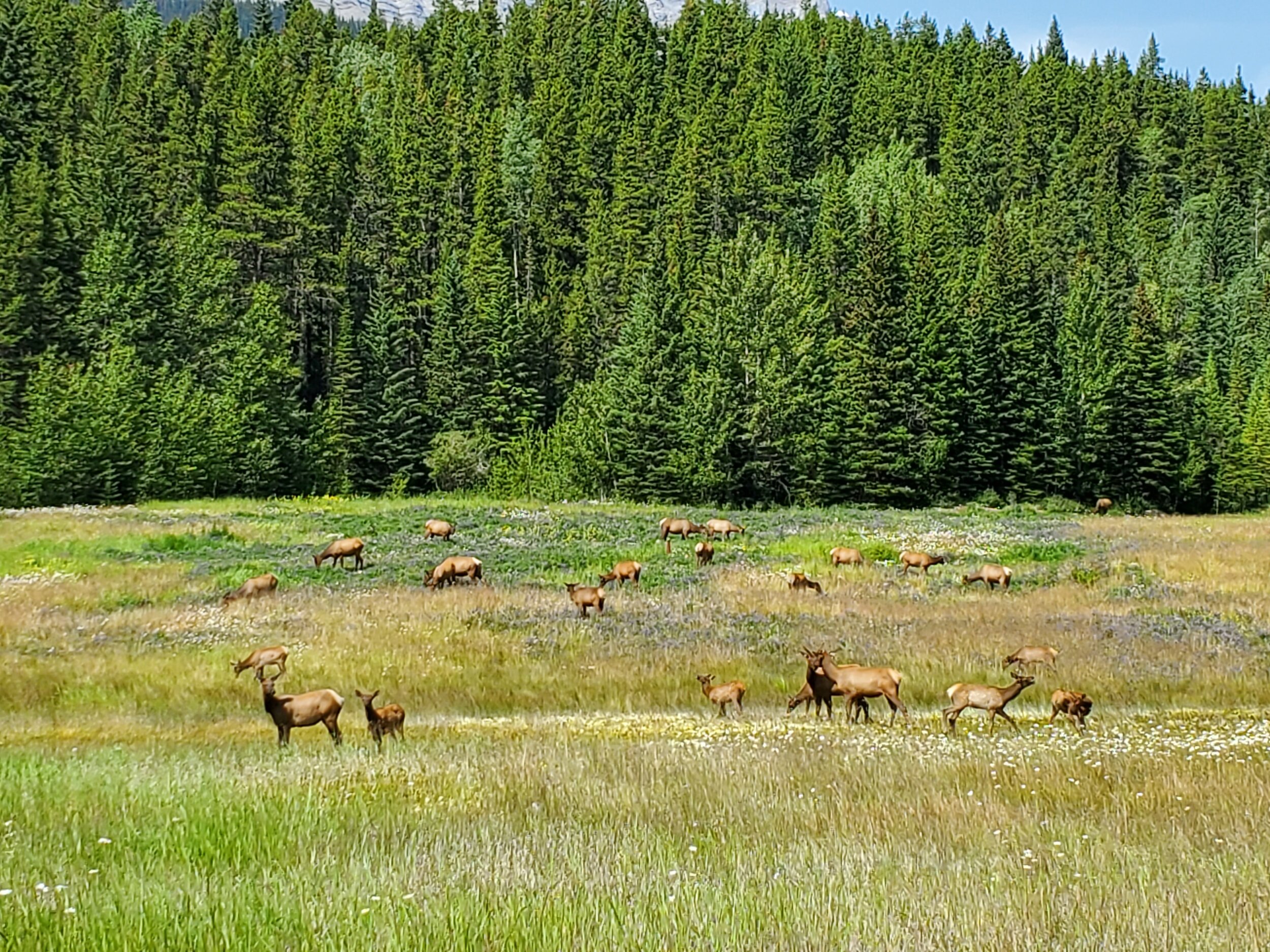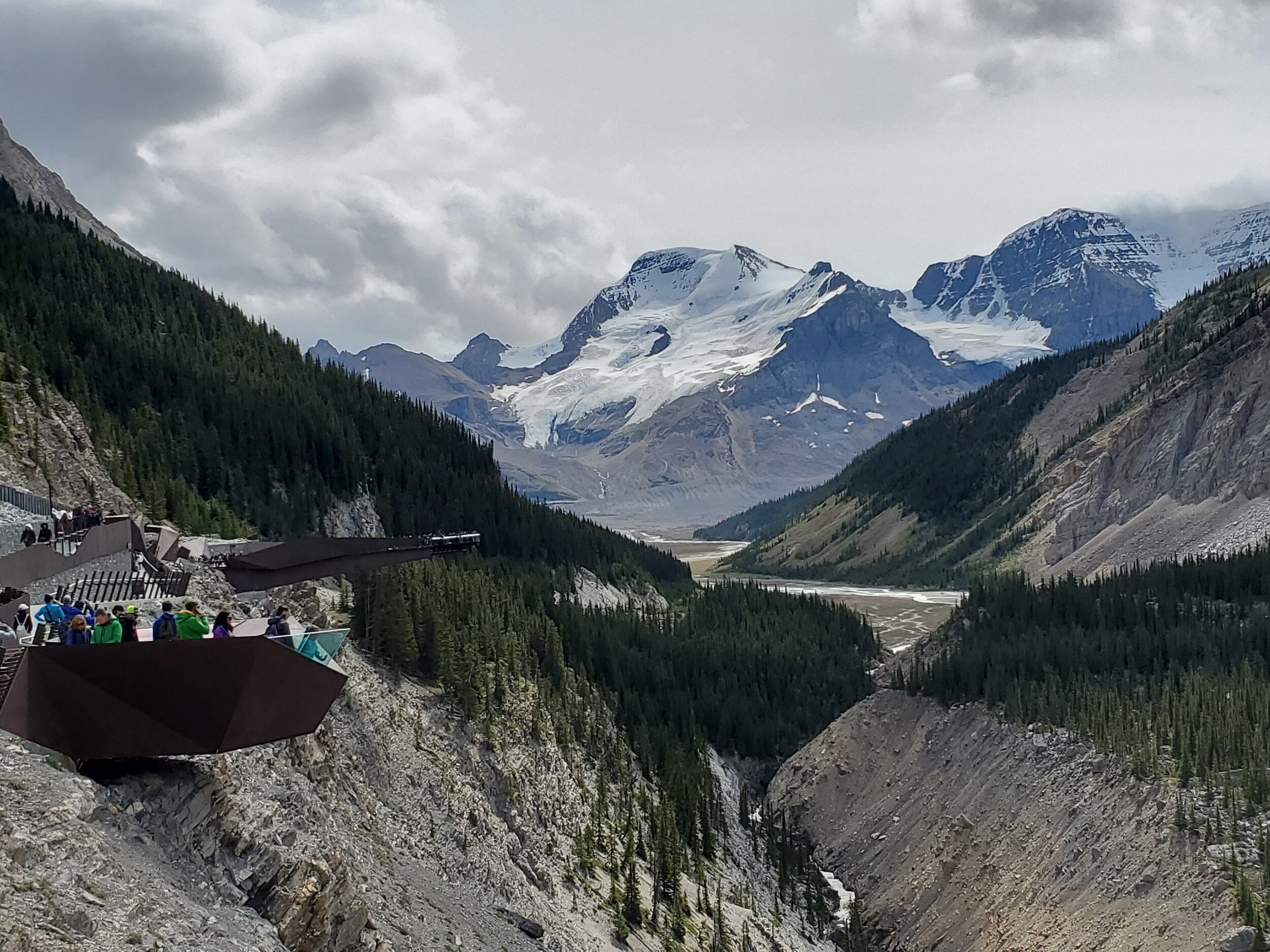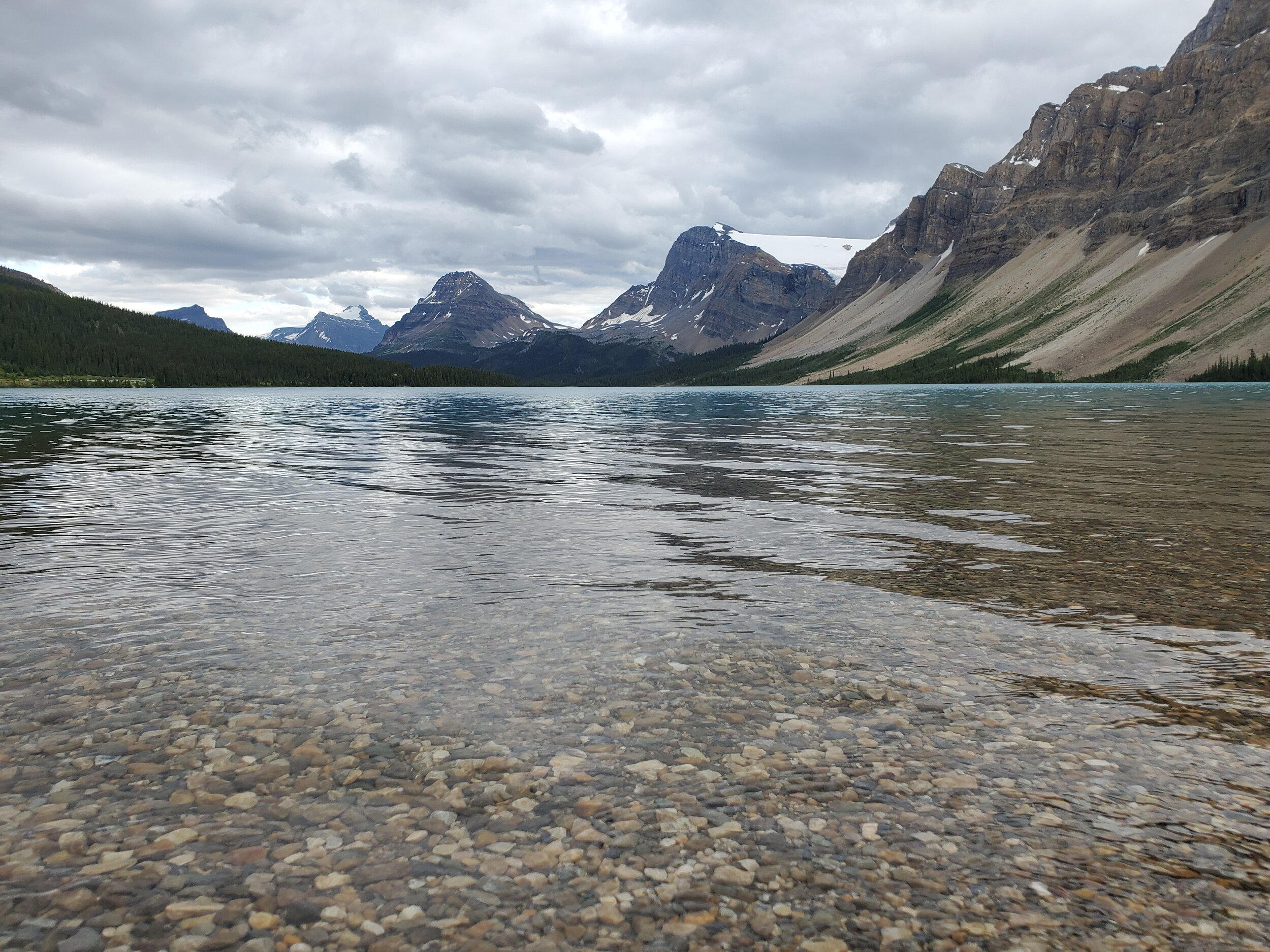Ultimate Guide to Banff National Park
Banff National Park has over 6,600 square kilometers to explore in the Canadian Rockies. With mountains, turquoise glacial lakes, waterfalls, and alpine tundra, this park has something for everyone to enjoy.
In this guide to Banff National Park, I’ll cover everything you need to know to plan a perfect trip based on my experience visiting the park.
Let’s get started!
Banff National Park Basic Information
Banff National Park is open 24/7 every day of the year.
There are 2 Visitor Centers:
Banff Visitor Centre which is located in the town of Banff is open from 8am - 6pm daily.
Lake Louise Visitor Centre is located next to Samson Mall in the village of Lake Louise and is open from 9am - 5pm daily.
Day passes are available and allow entry to Banff, Jasper, Kootenay, Yoho, Mount Revelstoke, Glacier, Waterton Lakes, and Elk Island national parks. Park entry is Can$10 per adult per day or Can$20 per family/group. Passes can be purchased online, at national park gates, information centers, or campgrounds.
Roam Public Transit services the town of Banff and provides access to several popular Banff attractions. There are 8 routes that service Banff:
Route 1: Sulphur Mountain
Route 2: Tunnel Mountain
Route 4: Cave and Basin
Route 6: Lake Minnewanka
Route 8X: Lake Louise Express
Route 8S: Lake Louise Scenic
Route 9: Johnston Canyon
Route 10: Moraine Lake Express
For more information of tickets, fares, and times, visit the Roam Transit website.
Parks Canada provides shuttles in the popular Lake Louise area as traffic can be very congested at times with limited parking available. There are 4 routes available:
Lake Louise Lakeshore
Moraine Lake
Lake Connector
Park and Ride Connector
Shuttle reservations are required and can be booked through the Parks Canada Reservation System.
Top Things to do in Banff National Park
Lake Louise Area:
Lake Louise Lakeshore
Distance: 2 km one way
Difficulty: Easy
Elevation Change: minimal
Trailhead Access: Upper Lake Louise parking area and can also be accessed via public transit.
Duration: 1 hour
Easy, accessible hike that allows you to walk around the lake.
Lake Agnes
Distance: 6.8 km roundtrip
Difficulty: Moderate
Elevation Change: 385 m
Trailhead Access: Upper Lake Louise parking area and can also be accessed via public transit.
Duration: 3 hours
Hike a well maintained trail that starts just past the Chateau grounds to hike up the mountain past Lake Louise. The first part of the hike will be mostly through the trees, and as you continue onward, you’ll start catching glimpses of the lake.
Once reaching Lake Agnes you can relax and get a drink and snack at the Lake Agnes Tea House. The Tea House is in operation from June 4th - Canadian Thanksgiving from 8am to 5pm and only accepts Canadian or US dollars. They offer over 100 different types of tea that utilize the water straight from Agnes Lake, along with sandwiches, soup, tea biscuits, bread loaves, cookies, and apple crumble.
Trekker Tip: Continue past Lake Agnes and head towards the Big Beehive trail. Once returning from Big Beehive, then stop and reward yourself with food and drink at the Tea House.
Big Beehive
Distance: 10 km roundtrip
Difficulty: Moderate
Elevation Change: 647 m
Trailhead Access: Upper Lake Louise parking area and can also be accessed via public transit.
Duration: 4 hours
From Lake Agnes, continue around the lake and up the mountain. You’ll hike up 8 switchbacks before reaching the top. Once at the top of the mountain, you’ll be rewarded with sweeping views of Banff National Park and amazing views overlooking Lake Louise.
Moraine Lake Lakeshore
Distance: 1.5 km one way
Difficulty: Easy
Elevation Change: minimal
Trailhead Access: Moraine Lake parking lot
Duration: 30 minutes
From the parking lot, there are numerous locations to get amazing views of the lake and surrounding mountains. You can cross the wobbly logs that are floating in the lake to reach a small hill that is a great spot for photographing the lake. Be prepared for the potential of falling in though, so plan on bringing extra socks, just in case.
Trekker Tip: Sunrise here is incredible, and should definitely be added to your must-see list. If planning to visit for sunrise, plan to arrive early as this is an extremely popular location for sunrise, and parking is very limited.
Banff Area:
Johnston Canyon
Distance: 5 km roundtrip
Difficulty: Moderate
Elevation Change: 330 m
Trailhead Access: Johnston Canyon day-use area
Duration: 4 hours
Travel through a narrow canyon across catwalks and bridges that affixed to the limestone cliffs. On the way, you’ll pass by the Lower Johnston Falls where you may get misted by water coming from the falls.
Once reaching the Upper Johnston Falls, there are two viewing areas. The first if access by crossing a bridge that leads to the bottom on the falls. The second viewing area can be reached by taking a steeper trail upwards, and through a small tunnel through the limestone to reach a platform overhanging the gorge.
Explore the Lake Minnewanka Loop
Take a scenic drive around the loop at the Lake Minnewanka area. There are numerous areas to stop around the loop, so depending on how much you want to do and how often you’re stopping, you can see the loop in about an hour or spend a full day exploring.
There are tons of wildlife that can be seen as you drive along the loop, making this one of the top sites for seeing wildlife. When we visited we saw numerous elk and bighorn sheep.
Icefields Parkway Area:
Tour Columbia Icefield
Take a guided tour of Athabasca Glacier. One of the best tours is Columbia Icefield Adventure (including Skywalk) tour offered by Banff Jasper Collection.
On this tour, you’ll depart from the Discovery Centre, which has a gift shop and food available. From here you’ll get on the Ice Explorer bus and drive out onto the glacier. Once on the glacier, you’ll have about 40 minutes to explore the glacier on your own, in a roped off section for your safety. From here, you’ll depart to the Skywalk which is a u-shaped glass-floored observation platform that is 280m above the Sunwapta Valley. You can spend as long as you want at the Skywalk before departing back to the Discovery Center. Most people spend about 1 hour at the Skywalk.
Athabasca Falls
Distance: 1 km roundtrip
Difficulty: Easy
Elevation Change: 46 m
Trailhead Access: Nearby parking lot off of Highway 93A
Duration: 30 minutes - 1 hour
The falls are located in Jasper National Park, but are along the Icefields Parkway. Take a short hike to reach the falls which drop 24m and have a width of 18m. These are considered the most powerful waterfalls in the Canadian Rockies, and are worth a short stop when driving the Icefield Parkway.
Sunwapta Falls
Distance: 3.2 km roundtrip
Difficulty: Easy
Elevation Change: 143 m
Trailhead Access: Parking lot off of the Icefields Parkway
Duration: 1 hour
Another short stop located along the Icefields Parkway that’s worth stopping at. It’s a short hike to the Lower Sunwapta Falls, and you can continue on a bit further to reach the Upper Sunwapta Falls. The falls have a drop of about 18m and are fed by the Athabasca Glacier.
Bow Lake
Located 30 minutes north of Lake Louise along the Icefields Parkway, Bow Lake is worth one last stop when returning to Banff. The lake is fed by the Bow Glacier in the Wapta Icefield and lies at the base of the Bow Summit. Take a quick stop here and enjoy the turquoise colors of the lake.
Additional Things to do at Banff National Park
Additional things to check out are:
Climbing
Opportunities for climbing exist in many areas across the park with various levels of difficulty. Some popular climbing spots are:
Mt Norquay’s Via Ferrata
Sunshine Rock
Black Band Area on Tunnel Mountain
Mother’s Day Buttress
Gooseberry on Tunnel Mountain
Back of the Lake - Lake Louise
Mt. Louis
Grand Sentinel
Boat Tours
The Banff Jasper Collection offers boat tours on Banff’s lakes.
There are several boat tours available that cruise along Lake Minnewanka. Times for each cruise vary, and are generally offered between June and October. Boats are heated and covered, meaning you can explore in any weather. You’ll be able to see wildlife from the boat as you cruise on Banff’s largest lake.
Boat tours are also available on Maligne Lake in Jasper National Park. Boats typically run between June 4th and Canadian Thanksgiving, with varying times throughout the year. On the cruise, you’ll be able to explore the crystal clear waters of Maligne Lake and visit Spirit Island.
Horseback Riding
Horse travel is permitted throughout most of the park, although, there are few trails and areas where horses are prohibited.
You must obtain a permit for horseback riding. Group sizes are limited to a maximum of 10 riders with 2 animals per rider. Horses must be prepared to encounter hikers, cyclists, and river crossings.
Swimming
You can hop into the glacier-fed lakes throughout the parks for some amazing photo ops. However, be prepared, as the lakes are extremely cold.
The nearby town of Banff offers some public pools for those looking for warmer areas to swim. For warmer water, you can also visit the Banff Upper Hot Springs.
Bicycling
Bicycling in the park is a great way to take in the views of the park. There are various routes throughout the park ranging from easy to difficult. The bicycling season typically runs from April to October depending on weather and conditions.
Check out the nearby town of Banff
Located inside Banff National Park, the town of Banff is surrounded by rugged mountains and embodies the spirit of a mountain town. The streets of downtown Banff are filled with numerous restaurants, bars, shops, museums, and art galleries.
Here you can find guides and equipment for hiking, camping, cycling, rock climbing, stand up paddle boarding, canoeing, and more.
Banff is a great town to explore while you get acclimated to the elevation or want a break from hiking. As it’s located inside the park, this is one of the most popular places to stay when visiting the park.
Check out the nearby town of Canmore
Another popular spot nearby Banff National Park, is the town of Canmore. Located about 20 minutes southeast of Banff, the town offers cheaper lodging than in Banff. The town also offers numerous restaurants, bars, shops, and art galleries, making it a great place to visit.
We also did a hike in Canmore to Grassi Lakes. This 4 km roundtrip hike takes you up a gentle incline where you’ll pass by a waterfall and have views overlooking Canmore and Bow Valley. At the top of the hike, you’ll be rewarded with a spectacular turquoise lake.
Where to Stay
Lodging in Banff:
The most popular place to stay is within the Town of Banff as it is located inside the national park. Lodging can be fairly expensive within Banff, but allows for quick access to numerous lakes and trails along with restaurants and bars in downtown Banff.
Popular places to stay in Banff are:
Fairmont Banff Springs
Moose Hotel & Suites
Hidden Ridge Resort
The Rimrock Resort
Banff Park Lodge Resort
Lodging in Lake Louise:
If you’re spending some time hiking in the Lake Louise area, you might consider spending a night or two near Lake Louise. The most iconic spot to stay in Lake Louise is at the Fairmont Chateau located right at the base of the lake. Staying here can be quite expensive, but you’ll be rewarded with amazing views and quick access to the lake.
Cheaper alternatives are:
Lake Louise Inn
Deer Doge
Mountaineer Lodge
Lodging in Canmore:
Canmore is located about 20 minutes southeast of Banff, and offers cheaper lodging than the town of Banff. The town also offers restaurants, bars, shops, and art galleries within walking distance of your lodging.
Popular places to stay are:
Grand Rockies Resort
Holiday Inn Canmore
Days Inn by Wyndham Canmore
Solara Resort & Spa
Silver Creek Lodge
Camping in Banff National Park:
Camping is permitted within Banff National park only in designated areas with a camping permit. Reservations are required along with an entry pass to the national park. Fees for campsites vary and can be found on the national park website.
Campground locations include:
Tunnel Mountain
Two Jack
Johnston Canyon
Castle Mountain
Protection Mountain
Lake Louise
Mosquito Creek
Rampart Creek
Silverhorn Creek
Waterfowl Lakes
Where to Eat
Dining in Banff:
The Bison Restaurant offers Canadian fare where you can eat on their scenic terrace.
Chuck’s Steakhouse located in downtown Banff offers a seasonal menu.
The Bear Street Tavern is a casual bar offering a grill and pizza.
Block Kitchen + Bar offers Asian-inspired tapas.
Saffron Indian Bistro offers casual dining and Indian cuisine.
Dining in Canmore:
Wild Orchid Bistro offers a gluten-free menu for Asian cuisine.
Gaucho offers a Brazilian menu.
Santa Lucia Trattoria offers Italian food with options to eat on their patio.
Red Rock Pizza Canmore is a casual restaurant offering Italian-American fares.
What to Pack
Good to protect your knees on longer, steeper hikes.
Definitely needed along with snow baskets if hiking in spring or early summer as there will still be snow on the trails.
Good hiking socks to keep your feet comfortable when scrambling over rocks or climbing up inclines.
As there are numerous lakes and river crossings throughout the park, it’s a good idea to pack a spare in case your socks get wet.
Bring waterproof hiking boots that are comfortable and you have a chance to break in before you set out on long hikes.
Needed for hikes in spring or early summer as you can still find snow and ice along the trails.
Keep your hands free while having space for your sunscreen, water, extra layers, quick dry towel, and more.
Is a must as some areas are exposed and do not offer much shade.
Stay hydrated while you’re hiking in the hot sun.
A roll-up hat you can pack in your day bag to keep cool as the temperature varies throughout the day.
Be prepared for cold weather when visiting Athabasca Glacier, as the glacier can be significantly colder than other areas of the park.
See additional packing suggestions for any trip here.












